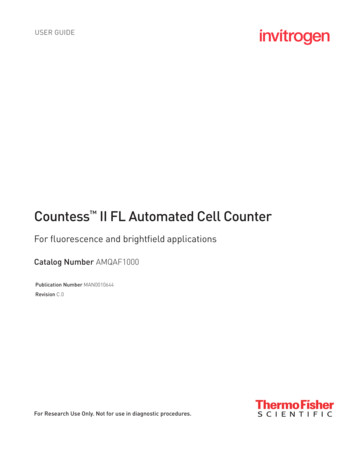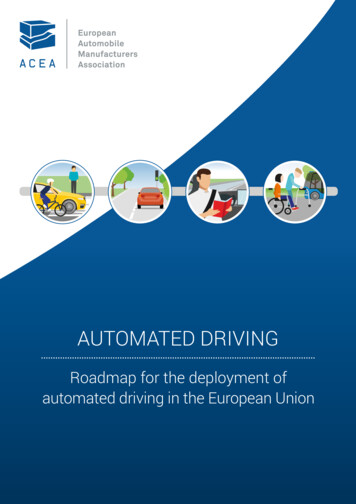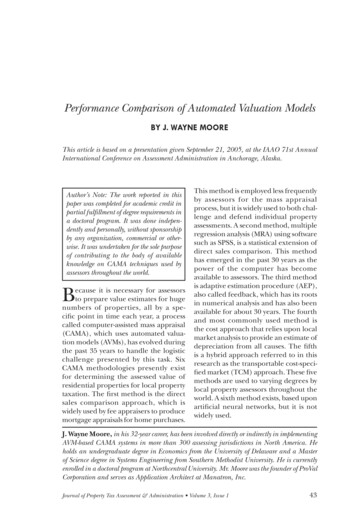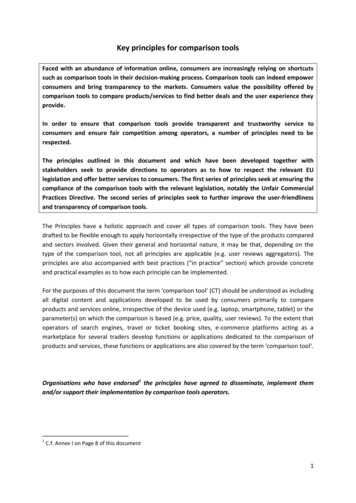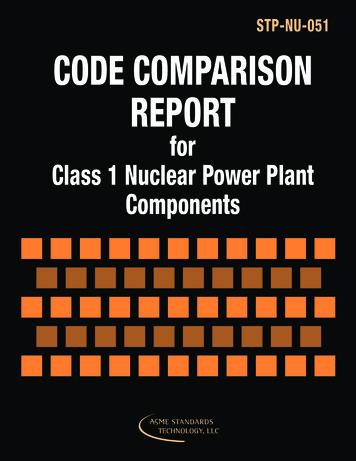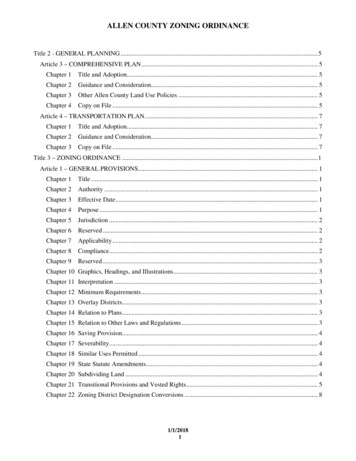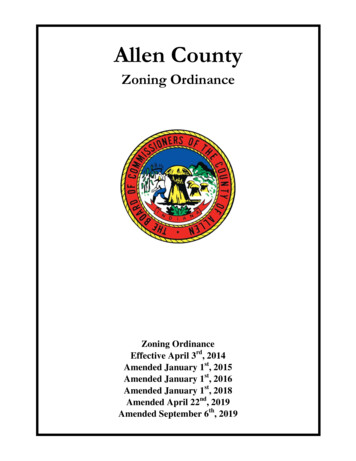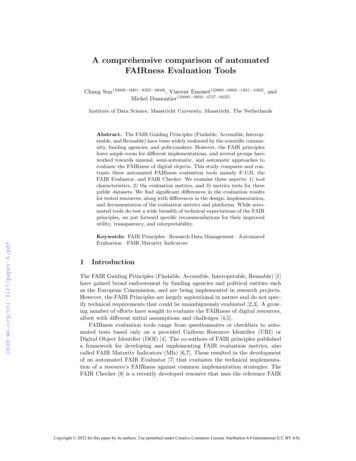
Transcription
A comprehensive comparison of automatedFAIRness Evaluation ToolsChang Sun1[0000 0001 8325 8848] , Vincent Emonet1[0000 0002 1501 1082] , andMichel Dumontier1[0000 0003 4727 9435]Institute of Data Science, Maastricht University, Maastricht, The NetherlandsAbstract. The FAIR Guiding Principles (Findable, Accessible, Interoperable, and Reusable) have been widely endorsed by the scientific community, funding agencies, and policymakers. However, the FAIR principlesleave ample room for different implementations, and several groups haveworked towards manual, semi-automatic, and automatic approaches toevaluate the FAIRness of digital objects. This study compares and contrasts three automated FAIRness evaluation tools namely F-UJI, theFAIR Evaluator, and FAIR Checker. We examine three aspects: 1) toolcharacteristics, 2) the evaluation metrics, and 3) metrics tests for threepublic datasets. We find significant differences in the evaluation resultsfor tested resources, along with differences in the design, implementation,and documentation of the evaluation metrics and platforms. While automated tools do test a wide breadth of technical expectations of the FAIRprinciples, we put forward specific recommendations for their improvedutility, transparency, and interpretability.Keywords: FAIR Principles · Research Data Management · AutomatedEvaluation · FAIR Maturity Indicators1IntroductionThe FAIR Guiding Principles (Findable, Accessible, Interoperable, Reusable) [1]have gained broad endorsement by funding agencies and political entities suchas the European Commission, and are being implemented in research projects.However, the FAIR Principles are largely aspirational in nature and do not specify technical requirements that could be unambiguously evaluated [2,3]. A growing number of efforts have sought to evaluate the FAIRness of digital resources,albeit with different initial assumptions and challenges [4,5].FAIRness evaluation tools range from questionnaires or checklists to automated tests based only on a provided Uniform Resource Identifier (URI) orDigital Object Identifier (DOI) [4]. The co-authors of FAIR principles publisheda framework for developing and implementing FAIR evaluation metrics, alsocalled FAIR Maturity Indicators (MIs) [6,7]. These resulted in the developmentof an automated FAIR Evaluator [7] that evaluates the technical implementation of a resource’s FAIRness against common implementation strategies. TheFAIR Checker [8] is a recently developed resource that uses the reference FAIRCopyright 2022 for this paper by its authors. Use permitted under Creative Commons License Attribution 4.0 International (CC BY 4.0).
MIs but offers an alternate user interface and result representation. F-UJI [9]is an automated FAIR evaluation tool with its own metrics and scoring system.While these tools aim to systematically and objectively measure the FAIRnessof the digital objects, they generate different FAIRness evaluation results owingto differences in strategies pertaining to information gathering, metric implementation, and scoring schemes.We sought to compare and contrast three automated FAIRness evaluationtools (F-UJI, the FAIR Evaluator, and the FAIR checker) against their usability, evaluation metrics, and metric tests results. We generate evaluation resultsusing three datasets from different data repositories. We discover the FAIRnessevaluation tools have different coverage and emphases on the FAIR principlesand apply different methods to discover and interpret the content of the digitalobjects. When assessing the comparable evaluation metrics, different tools mayoutput conflicting results because of the different implementation of the metrictests. We analyze these observed differences and explore their likely bases. Ourwork is the first to offer a systematic evaluation of current automated FAIRnessevaluators, with concrete suggestions for improving their quality and usability.2Materials and MethodsThis study critically examines the functioning of the FAIR Evaluator, FAIRChecker, and F-UJI. These FAIRness evaluation tools are implemented asweb applications that use web service APIs to execute a FAIRness evaluation andoffer an interactive user interface through a web browser (Figure 1). These toolsimplement new or apply existing FAIRness evaluation metrics. Each metrichas one or more compliance metric tests to determine if the digital object meetsthe requirements of the metric. These metric tests are the actual implementationof the evaluation metrics. Users invoke an evaluation by providing a valid URL orpersistent identifier (PID) of the digital object’s landing page. The tool executesa strategy to harvest relevant metadata on the URL (or its redirected URL) usinga combination of content negotiation, embedded microdata, and HTTP meta rellinks. The tools then test the harvested metadata, and tabulate whether and/orhow they pass or fail the metric test(s). Finally, the tools present the results ofthe metric tests as an HTML web page that may otherwise be downloadableas a structured data file. We conducted a comprehensive comparison of theautomated FAIRness evaluation tools focusing on 1) the characteristics of theevaluation tools, 2) the FAIRness evaluation metrics, and 3) the testing resultsusing three public datasets.Fig. 1. A general workflow of FAIRness evaluation tools2
2.1Characteristics of the FAIRness evaluation toolsThe automated evaluation tools are accessible via web applications and APIs.We extracted key features and specifications and reflected on the transparency(in terms of documentation) and extensibility of the tools. The elements such asthe availability of source code, web application, the required inputs, the quality,and interpretation of the outputs are included.2.2FAIRness Evaluation Metrics and metric TestsAt the heart of automated FAIRness evaluation are programs that examine dataresources for the presence and quality of particular characteristics. F-UJI implemented FAIRsFAIR Data Object Assessment Metrics [10], while the FAIR Evaluator implemented FAIRness Maturity Indicators (MIs) [6,7]. The FAIR Checkerapplies the same MIs as the FAIR Evaluator but implements a distinct web application with a different user interface. Our comparison on evaluation metrics liesbetween those used by F-UJI and the FAIR Evaluator/FAIR Checker. The FAIREvaluator documented the measurements and procedures of metric tests throughNanopublication, which is readable for both machines and humans. The sourcecode for the metric tests and evaluator application is available. F-UJI presentsthe names of their metric tests on the web application and published the sourcecode of the tests. The log messages from both tools potentially indicate whatproperties are assessed in the (meta)data. We compare each metric/indicatorfrom both tools and pair the metrics that are comparable to each other basedon their descriptions, metric tests, and output log messages.2.3Tests on three public datasetsThe last comparison focuses on the representation and interpretation of theevaluation results from F-UJI and the FAIR Evaluator. Three tested datasets inTable 1 are from PANGAEA [11], Kaggle [12], and Dutch Institute for PublicHealth and Environment (RIVM) [13]. PANGAEA assists the users to submitdata following FAIR principles. All submitted data are quality checked and processed for machine readability. Kaggle recommends but is not mandatory forusers to upload data with description and metadata. Unlike PANGAEA andKaggle that are open to the general users to upload data, the RIVM data portalhosts data from governmental or authorized resources. Due to the current trendof COVID-19, CORD-19 and NL-Covid-19 were selected to evaluate their FAIRness. GeoData was included because of its descriptive metadata and qualitychecked submission. The datasets are evaluated on F-UJI using its evaluationmetrics v0.4 and software v1.3.5b and the FAIR Evaluator using its metric collection - “All Maturity Indicator Tests as of May 8, 2019”.NameHostInput for the assessment toolsGeoDataPANGAEA te-for- m.nl/meta/srv/eng/rdf.metadata.get?uuid 1c0fcdNL-Covid-19 RIVM57-1102-4620-9cfa-441e93ea5604&approved trueInput typeDOIMetadatalanding pageMetadatain RDFTable 1. Datasets for testing the automated FAIRness evaluation tools3
3ResultsThis section presents the results and analysis of comparing three evaluationtools. Comparison of the characteristics of the tools was performed with theFAIR Evaluator, FAIR Checker, and F-UJI, whereas a comparison of evaluationmetrics was performed only with the FAIR Evaluator and F-UJI, as the FAIRChecker applies the same evaluation metrics as the FAIR Evaluator.3.1Comparison of characteristics of the evaluation toolsAs table 2 shows, all tools are implemented as a standalone web applicationand API. Execution of the FAIRness evaluation is as follows: F-UJI requestsa persistent identifier (PID) of the data or the URL of the dataset’s landingpage as input, while the FAIR Evaluator requests a global unique identifier(GUID) of the metadata. The following schemes are considered as PIDs by bothtools: Handle, Persistent Uniform Resource Locator, Archival Resource Key,Permanent identifier for Web applications, and Digital Object Identifier. Bothoffer short descriptions about the input, while the FAIR Checker simply requestsa URL or DOI without further explanation.After the execution of the evaluation, each application presents the resultsdifferently. The FAIR Checker starts with a radar chart outlining the FAIRnessscores along 5 axes (Findable, Accessible, Interoperable, Reusable, Total). TheFAIR Checker does not provide detailed logs except the error messages. TheFAIR evaluator presents the results of metric tests with the detailed applicationlevel logs. The results are assigned with PIDs and stored in a persistent databasewhere users can search, access, and download as a JSON-LD file. The F-UJI alsoprovides application-level logs as feedback to the rationality of the test results.However, the logs are not as detailed as the FAIR Evaluator. The results fromF-UJI can be downloaded as a JSON file. F-UJI and the FAIR Evaluator areboth based on APIs to make their FAIRness evaluation services accessible.F-UJIFAIR EvaluatorWeb application [www.f-uji.net](v1.3.5b) [w3id.org/AmIFAIR](v0.3.1)Requested inputResults exportOutputMetricsSource codeLanguageAssociatedproject/groupPID,URL of datasetJSONApplication-level honFAIRisFAIRGUID of the metadataJSON-LDApplication-level ringFAIR Metrics GroupFAIR Checker[fair-checker.france-bioinformatique.fr] (v0.1)URL,DOINot availableError nFrench Institute forBioinformaticsTable 2. Comparison of FAIRness evaluation tools3.2FAIRness Evaluation MetricsThe latest evaluation metrics from F-UJI include 17 metrics to address the FAIRprinciples with the exception of A1.1, A1.2, and I2 (open protocol, authentication and authorization, FAIR vocabularies). The metrics are documented with4
identifiers, descriptions, requirements, and other elements [10]. The FAIR Evaluator used a community-driven approach to create 15 Maturity Indicators (MIs)covering the FAIR principles except for R1.2 and R1.3 (detailed provenance,community standards). The MIs are documented in an open authoring framework (https://github.com/FAIRMetrics/Metrics) where the community cancustomize and create domain-relevant, community-specific MIs. Table 3 showsthe comparison of F-UJI evaluation metrics v0.4 and the metric collection - ”AllMaturity Indicator Tests as of May 8, 2019” from the FAIR Evaluator corresponding to the FAIR principle. The comparable metrics are paired in the table.F-UJI has two metric tests on data and three tests on metadata to assessthe findability, while the FAIR Evaluator has six tests on metadata. The FAIREvaluator requires PID for both metadata and data, while F-UJI only requiresfor the data. Two tools both check if the metadata is structured using JSON-LDor RDFa. However, the FAIR Evaluator requires metadata to be grounded inshared vocabularies using a resolvable namespace. F-UJI checks the predefinedcore elements in the metadata, such as title, description. and license.Two tools evaluate the accessibility by assessing communication protocolsfor retrieving (meta)data, ensuring the (meta)data can be accessed through astandard protocol. The FAIR Evaluator requires authentication implementationon the data and authorizations on metadata, while F-UJI only requires metadataauthorizations. The metadata persistence is discussed by both tools, but F-UJIdoes not implement it in their tool. The argument is that programmatic evaluation of the metadata preservation can only be tested if the object is deleted orreplaced [10]. However, the FAIR Evaluator measures the metadata persistenceby looking for a persistence policy key or predicate in the metadata.To evaluate the interoperability, the FAIR Evaluator tests whether themetadata and data are structured and represented using ontology terms. F-UJIonly focuses on the structure of metadata. Compared to F-UJI, the FAIR Evaluator has extensive measurements on both metadata and data to evaluate theinteroperability. In the evaluation of reusability, F-UJI has more comprehensivemeasurements than the FAIR Evaluator. The FAIR Evaluator checks if licenseinformation is included in the metadata. By contrast, F-UJI setup four tests formetadata and one test for data to check the richness, licenses, and provenanceof metadata and applied community-standards in metadata and data.3.3Compare the test results on public datasetsThe evaluation results of three datasets are shown in Table 4. The full resultsare accessible on https://doi.org/10.5281/zenodo.5539823. Geodata scoredperfect on all the metrics from F-UJI, but 17 out of 22 from the FAIR Evaluator.4 out of 5 failed tests in the FAIR Evaluator assessed aspects that are not listedin F-UJI. The test on the persistence of the data identifier (F1-01D, F1-02D,MI F1B) had different results from F-UJI and the FAIR Evaluator. Additionally,if qualified outward references in metadata (I3-01M, MI I3A) and licenses inmetadata (R1.1-01M, MI R1.1) also had different results from two evaluators onthe tested datasets. These differences are examined further in the Discussion.5
6A2-01MA1.1A1.1A1.2A1.2FA2MI R1.1MI R1.1R1-01MD Metadata specifies the content of the data.R1.1-01M Metadata includes license information.----Metadata Includes License (weak)Metadata Includes License (strong)-Metadata contains qualified outward referencesMetadata includes links between data and related entities. MI I3AREUSABLEMetadata Knowledge Representation Language (weak)Metadata Knowledge Representation Language (strong)Data Knowledge Representation Language (weak)Data Knowledge Representation Language (strong)Metadata uses FAIR vocabularies (weak)Metadata uses FAIR vocabularies (strong)Uses open free protocol for metadata retrievalUses open free protocol for data retrievalMetadata authentication and authorizationData authentication and authorizationMetadata Persistence-MIMIMIMIMI----Metadata is represented using a formal knowledge repre- MI I1AMI I1Bsentation language.Metadata uses semantic resourcesMI I1AMI I1BMI I2AMI I2BINTEROPERABLEMetadata contains the access level and access conditionsof the data.Metadata is accessible through a standardized communication protocol.Data is accessible through a standardized communicationprotocol.–Metadata remains available, even if the data is no longeravailable. (This metric is disabled in F-UJI tool.)ACCESSIBLEUse of (data) GUIDs in metadata(Metadata) Searchable in major search enginesMetadata includes the identifier of the data it describes. MI F3Metadata can be retrieved programmatically.MI F4Name(Metadata) Identifier uniqueness(Metadata) Identifier persistence(Data) Identifier uniqueness(Data) Identifier PersistenceStructured MetadataGrounded MetadataFAIR Evaluator/FAIR CheckerUse of (metadata) GUIDs in metadataFINDABLENameID(Gen )MI F1AMI F1BData is assigned a globally unique identifier.MI F1AData is assigned a persistent identifier.MI F1BMI F2AMetadata includes descriptive core elements to support MI F2Bfindability.MI F3F-UJIR1.2-01M Metadata includes provenance information about data cre- ation or generation.R1.3. (meta)data meet domain-relevant R1.3-01M Metadata follows a standard recommended by the target research community of the data.community standards.R1.3-02D Data is available in a file format recommended by the tar- get research community.R1. meta(data) are richly described withaccurate and relevant attributes.R1.1. (meta)data are released with a clearand accessible data usage license.R1.2. (meta)data are associated with detailed provenance.I1-01MI1. (meta)data use a formal, accessible,shared, and broadly applicable language for I1-02Mknowledge representation.I2. (meta)data use vocabularies that follow FAIR principles.I3. (meta)data include qualified referencesI3-01Mto other (meta)data.A1.1 the protocol is open, free, and universally implementable.A1.2 the protocol allows for an authentication and authorization procedure.A2. metadata are accessible, even when thedata are no longer available.A.1 (meta)data are retrievable by theiridentifier using a standardized communica- A1-02Mtions protocol.A1-03DA1-01MF3: metadata clearly and explicitly include the identifier of the data they describe.F3-01MF4: (meta)data are registered or indexed in F4-01Ma searchable resource.ID(FsF-)F1: (meta)data are assigned a globally F1-01Dunique and persistent identifier.F1-02DF2: data are described with rich metadata. F2-01MFAIR MetricsTable 3: Comparison of FAIRness evaluation metrics from all tools.
FEF-UJIF1-01DF1-02DF4-01MMI F1BMI F3MI F4GeoDataF-UJI FE333733CORD-19F-UJI FE373737NL-Covid-19F-UJI FE377777A1-01M-3-3-7-I1-02MI3-01MMI I2BMI I3A337373733733R1.1-01M MI R1.1333737R1.3-01M 373R1.3-02D 373Passed/total tests: 16/16 17/22 12/16 13/22 11/16 13/22Table 4. Selected results of evaluating datasets using F-UJI and FAIR Evaluator (FE).CORD-19 failed 4 tests in F-UJI and 9 tests in the FAIR Evaluator mostly inthe evaluation of the I and R. The poor quality of metadata of CORD-19 causesfurther failures in the other tests in both evaluation tools such as the persistenceof the metadata identifier (F1-02D), metadata includes license (MI R1.1). NLCovid-19 had the lower FAIRness score from F-UJI among the three datasets(11 out of 16) and 13 out of 22 in the FAIR Evaluator. It has the same issue ofthe quality of metadata as the second dataset, but outperformed in the knowledge representation in data. Neither F-UJI nor the FAIR Evaluator detected thelicense information in the metadata of NL-Covid-19, but the metadata clearlyindicates NL-Covid-19 comply with a valid license.4DiscussionThis study compares three automated FAIRness evaluation tools on the characteristics of the tools, the evaluations metrics and metric tests, and the resultsof evaluating 3 datasets. The outstanding feature of the FAIR Evaluator is thecommunity-driven framework that can be readily customized, by creating andpublishing an individual or collection of Maturity Indicators (MIs) to meet thedomain-related and community-defined requirements of being FAIR. The MIsand metric tests that are registered by one community are discovered and canbe grouped to maximize the reusability across communities. All published MIsand conducted FAIRness evaluations are stored in a persistent database and canbe browsed and accessed by the public. F-UJI visualizes the evaluation resultsand represents the output with better aesthetics. The source code is publiclyavailable in Python, and well-structured for each metric test. The FAIR Checkeruses the FAIR Evaluator API to perform the resource assessment, and has amore aesthetic presentation including recommendations to the failed tests, butdoes not allow the selection of particular metrics tests or collections, and doesnot offer the detailed output.4.1Transparency of the FAIRness evaluation toolsAll the evaluation tools suffer from some aspect of clarity and transparency.F-UJI’s source code is open and each evaluation metric is described in an accompanying article. However, without technical specifications of the application7
functioning, it is challenging to scan the whole code repository to learn how eachmetric was technically implemented. It is unclear what properties are assessedand how to improve the FAIRness of the objects. F-UJI gives a FAIRness scoreand a maturity score to the digital objects based on the metric tests. But it islacks of description of how these tests are scored and how the scores are operated.The FAIR Evaluator published its MIs and metric tests in a public Git repository. The web application of the FAIR Evaluator presents detailed log messageswhich potentially indicate what has been tested and what caused the test failure.However, the users still suffer from the insufficient transparency of the implementation. The FAIR Checker only generates the final test results (pass or notpass) without further explanations.4.2Differences among the toolsIn the comparison of the evaluation metrics, F-UJI has comprehensive metricsfor Reusability, while the FAIR Evaluator focuses on the Interoperability. Theevaluation results from three datasets reveal more significant differences betweenF-UJI and the FAIR Evaluator which result in conflicting results for the samemetric. We summarize the following three key reasons.1) Different understanding of certain concepts. When evaluating Geodata, F-UJI recognizes the DOI (10.1594/PANGAEA.908011) as the data identifier. F-UJI considers DOI as a persistent identifier (PID) and determines thatGeodata has a valid PID for the data. However, the FAIR Evaluator defined theDOI as the identifier for the metadata instead of the data. The data downloadURL is recognized as the data identifier by the FAIR Evaluator. Thus, F-UJIand the FAIR Evaluator have different understanding and definitions of dataand metadata identifiers, which result in differing test results.2) Different depth of information extraction. F-UJI and the FAIREvaluator gave conflicting results in determining whether metadata containedlicense information in CORD-19. F-UJI reported that license information wasfound, while the FAIR Evaluator did not recognize the license. From the outputlogs, two tools were both able to capture “Other (specified in description)” asthe license information in the metadata. However, the FAIR Evaluator failed the“metadata contains licenses” test because the FAIR Evaluator requires a validvalue of a license property (i.e. a URL). F-UJI passed the test but the giveninformation for the license property is not recognized as a valid license.When evaluating NL-Covid-19, F-UJI and the FAIR Evaluator both failed thetest on “metadata contains licenses”. However, the license information is clearlyincluded in the metadata of NL-Covid-19 (RDF format) with two statements.F-UJI is unable to find the license predicate in the metadata, while the FAIREvaluator found the license predicate but only processed the first statement “Geen beperkingen” as an invalid license. Unfortunately, the FAIR Evaluator didnot continue to process the second statement which contains the valid licenseinformation. In this case, neither F-UJI nor the FAIR Evaluator are able to findthe valid licenses in the metadata of NL-Covid-19.8
3) Different implementations of the metrics. F-UJI and the FAIR Evaluator both examine whether the relationships within (meta)data between localand third-party data are explicitly indicated in the metadata (I2-01M, MI I3A).In the evaluation of NL-Covid-19, the FAIR Evaluator passed the test by discovering 26 out of 45 triples in the linked metadata pointed to resources thatare hosted by a third party. F-UJI did not pass this test because it could notexact any related resources from the metadata. The conflicting test outcome results from the different implementation of recognizing the relationship betweenthe local and third-party data. F-UJI requires the relationship properties thatspecify the relation between data and its related entities have to be explicit inthe metadata and use pre-defined metadata schemas (e.g., “RelatedIdentifier”and “RelationType” in DataCite Metadata Schema). Compared to F-UJI, theFAIR Evaluator has a broader requirement for acceptable qualified relationshipproperties by including numerous ontologies which include richer relationships.4.3Potential limitationsThis study has several limitations. The comparison of evaluation metrics between F-UJI and the FAIR Evaluator is based on the description of each metric,metric tests, and log messages. We did not conduct a detailed examination oftheir implementation. The FAIR Evaluator published technical specifications foreach Maturity Indicator and its metric tests as well as the source code of implementation. F-UJI shares its source code and descriptions of the metrics inan article. However, metric tests and their implementation have not been sufficiently discussed. A possible solution for comparing the evaluation tools on theimplementation level is to scan their entire source code. However, this will require an extensive effort by experts in both Ruby and Python to conduct thistask.The discovery of the evaluation results from the three tools is possibly limited by our selection of the datasets. To increase the objectiveness of the evaluation, more representative datasets from various data repositories are requiredto test the different evaluation tools. A potential solution could be to constructa framework that evaluates and compares the FAIRness evaluation tools in anautomatic and systematic manner. The framework executes the evaluation toolson a set of standard benchmarking datasets, examines what properties are beingtested, and generates evaluation results automatically. This automated evaluation framework will overcome the qualitative nature of the current study andthe shortcomings of requiring substantial manual effort and proning to the errors. Finally, the evaluation tools in this study are all under active development.The evaluation metrics and implementations of metric tests in these tools canprobably be changed over time.5ConclusionThis study conducted a comprehensive comparison among three automatedFAIRness evaluation tools (F-UJI, the FAIR Evaluator, and the FAIR checker)9
covering the tool characteristics, evaluation metrics and metric tests, and evaluation results of three public datasets. Our work revealed differences among thetools and offers insights into how these may lead to different evaluation results.Finally, we presented the common issues shared by all FAIRness evaluation toolsand discussed the advantages and limitations of each tool. We note the tools areunder active development and are subject to change. Future work could focuson standardized benchmarks to critically evaluate the functioning of these andfuture FAIRness evaluation tools.References1. M. D. Wilkinson, M. Dumontier, I. J. Aalbersberg, G. Appleton, M. Axton,A. Baak, N. Blomberg, J.-W. Boiten, L. B. da Silva Santos, P. E. Bourne, et al.,“The fair guiding principles for scientific data management and stewardship,” Scientific data, vol. 3, no. 1, pp. 1–9, 2016.2. B. Mons, C. Neylon, J. Velterop, M. Dumontier, L. O. B. da Silva Santos, and M. D.Wilkinson, “Cloudy, increasingly fair; revisiting the fair data guiding principles forthe european open science cloud,” Information Services & Use, vol. 37, no. 1,pp. 49–56, 2017.3. A. Ammar, S. Bonaretti, L. Winckers, J. Quik, M. Bakker, D. Maier, I. Lynch,J. van Rijn, and E. Willighagen, “A semi-automated workflow for fair maturityindicators in the life sciences,” Nanomaterials, vol. 10, no. 10, p. 2068, 2020.4. R. de Miranda Azevedo and M. Dumontier, “Considerations for the conduction andinterpretation of fairness evaluations,” Data Intelligence, vol. 2, no. 1-2, pp. 285–292, 2020.5. “Fairassist - discover resources to measure and improve fairness.” https://fairassist.org/, 2021. Accessed: 2021-09-28.6. M. D. Wilkinson, S.-A. Sansone, E. Schultes, P. Doorn, L. O. B. da Silva Santos, and M. Dumontier, “A design framework and exemplar metrics for fairness,”Scientific data, vol. 5, no. 1, pp. 1–4, 2018.7. M. D. Wilkinson, M. Dumontier, S.-A. Sansone, L. O. B. da Silva Santos, M. Prieto,D. Batista, P. McQuilton, T. Kuhn, P. Rocca-Serra, M. Crosas, et al., “Evaluatingfair maturity through a scalable, automated, community-governed framework,”Scientific data, vol. 6, no. 1, pp. 1–12, 2019.8. informatique.fr/basemetrics, 2021. Accessed: 2021-09-28.9. A. Devaraju, M. Mokrane, L. Cepinskas, R. Huber, P. Herterich, J. de Vries, V. Akerman, H. L’Hours, J. Davidson, and M. Diepenbroek, “From conceptualization toimplementation: Fair assessment of research data objects,” Data Science Journal,vol. 20, no. 1, 2021.10. A. Devaraju, R. Huber, M. Mokrane, P. Herterich, L. Cepinskas, J. de Vries,H. L’Hours, J. Davidson, and A. White, “Fairsfair data object assessment metrics,” Zenodo, Jul, vol. 10, 2020.11. “Pangaea - data publisher for earth & environmental science.” https://www.pangaea.de/, 2021. Accessed: 2021-09-22.12. “Kaggle: Your machine learning and data science community.” https://www.kaggle.com/, 2021. Accessed: 2021-09-22.13. “Dutch institute for public health and environment data portal.” home, 2021. Accessed: 2021-09-22.10
Finally, the tools present the results of the metric tests as an HTML web page that may otherwise be downloadable as a structured data le. We conducted a comprehensive comparison of the automated FAIRness evaluation tools focusing on 1) the characteristics of the evaluation tools, 2) the FAIRness evaluation metrics, and 3) the testing results




